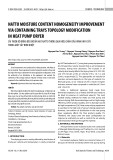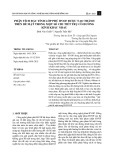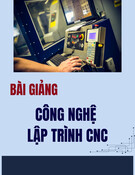
http://www.iaeme.com/IJMET/index.asp 1419 editor@iaeme.com
International Journal of Mechanical Engineering and Technology (IJMET)
Volume 10, Issue 03, March 2019, pp. 1419-1430. Article ID: IJMET_10_03_143
Available online at http://www.iaeme.com/ijmet/issues.asp?JType=IJMET&VType=10&IType=3
ISSN Print: 0976-6340 and ISSN Online: 0976-6359
© IAEME Publication Scopus Indexed
PRACTICAL DESIGN AND TESTING OF WIND
DRIVEN WATER PUMPING SYSTEMS
Ahmad S. Awad
Mechanical Engineering Department, Faculty of Engineering Technology, Al Balqa` Applied
University, Amman-Jordan, (corresponding author, Email: ahmadawwad@bau.edu.jo
ABSTRACT
Wind energy is that clean, green, available and one of the most economical
renewable energy source. Wind driven water pumping systems – windmills- are some
of the older machines. Long time ago, windmills have been developed by many cultures
to lift water for livestock, land drainage, irrigation and domestic supplies. As found
from other wind projects and studies, the most economical and useful application that
can be installed in the Jordanian arid regions is the wind pumping system using
Windmill. The Windmill is a perfect choice for our region because it doesn’t need high
wind speed and the wind torque can be achieved by using large rotors. The windmill
converts kinetic energy in wind into mechanical energy and then into hydraulic energy
into the pump. The 24 blade classic windmills are the most common type of windmills
which it is the one that been chosen for the present study. Achieving the goal of this
study could be done by the careful design of the rotor, transmission system and the
pump. A good pump design will raise the system efficiency. A design is made and all
calculations showed a very good pumping output. Then the model is manufactured in
the faculty of engineering workshop from local materials. It is designed to be used in a
wind speed of about 3.5 m/s at 8 m tower elevation. The goal is to pump 15 m3/day of
water to cover the student services building needs. The test after installation showed
that the pumping flow rate of 0.2 L/sec has been achieved; this result shows that the
designed and manufactured wind pumping system can pump more than the record which
allows storage of water.
Keyword head: wind energy, water pumping, windmills, pumping design
Cite this Article Ahmad S. Awad, Practical Design and Testing of Wind Driven Water
Pumping Systems, International Journal of Mechanical Engineering and Technology,
10(3), 2019, pp. 1419-1430.
http://www.iaeme.com/IJMET/issues.asp?JType=IJMET&VType=10&IType=3
1. INTRODUCTION
Today windmills are making a comeback thanks to rising conventional energy prices and the
threat of energy shortages. With the rise in oil prices in the early 1970s, interest in wind pumps
revived [1, 2]. However, the introduction of current multi conventional windmills in developing

Practical Design and Testing of Wind Driven Water Pumping Systems
http://www.iaeme.com/IJMET/index.asp 1420 editor@iaeme.com
countries has been hampered by the cost of importing (or importing the materials needed to
manufacture them) and maintenance requirements. But as new and more efficient wind turbines
development and production costs are reduced through the use of materials obtained locally,
the costs of pumping water with wind pumps can be decrease. A piece of equipment, which
requires only the wind to operate and properly installed and maintained, can give more than 40
years of reliable service is a very attractive investment indeed. For most developing countries,
renewable energy has been identified as an attractive alternative to solve their problems. Its
attractiveness to developing countries grew out of the illusion that entry into the period of
renewable energy technology could be achieved with great success without any real investment
in scientific and technological capabilities. Wind energy technologies continue to mature;
Performance is becoming better and more reliable, while at the same time costs continue to
decline [3- 6]. Environmental issues are becoming very important because of the increase in
energy consumption that has resulted in a significant impact on the health and safety of the
human population. The Natural Resources Authority (NRA) and the Water Authority (WA) in
Jordan agreed to implement a field project to pump water from deep wells using wind energy.
A system consisting of a multi-sheet windmill, storage tanks and pumps [7, 8 and 9] was
purchased, installed and tested. The Royal Scientific Society (RSS) has designed, built and
tested a number of different models of mechanical wind pumps (MWPs). The program aims to
strengthen the (RSS) experience and knowledge to be able to design and build different wind
energy conversion systems (WECS) for different applications that fit the local conditions of
Jordan [10, 11].
Bragg and Schmidt [10] presented a procedure that allows optimum selection of pumps and
windmills for a given water pumping station. They found that when wind information, pump
characteristics and windmill characteristics are available, one can select the best pump and
windmill for the application and can predict the design of the entire system.
In the year 2012, the Jordanian government issues the Renewable Energy and Energy
Efficiency law, which states that the government of Jordan should work on: Exploiting
renewable energy sources for increasing the percentage of their contribution to the total energy
mix and contributing to environmental protection and achieving sustainable development by
promoting the exploitation of renewable energy and improving its efficiency in various sectors
[15]. To meet with the goals set by the Jordanian national energy strategy, the objectives of the
present study are to design, manufacture and test the performance of locally made windmill for
water pumping to determine wind energy potential in our faculty and to direct research and
development of wind energy towards the beneficial applications in Jordan.
2. WIND ENERGY IN JORDAN
Jordan has no verified and usable oil or gas reserves. Jordan like other developing countries
depends entirely on imported oil for meeting its needs of commercial energy and its location in
an area with high political insecurity has had an inhibiting effect on its ability to import energy.
It has a heavy dependence on fossil fuels when Jordan currently imports around 96 percent of
its energy needs, accounting for over 20 percent of GDP for the energy bill [16]. The annual
growth rate of energy and electricity demand amount to 3%, and the maximum power demand
is expected to be doubled in the next decade. So that the wind energy can be one of the
renewable energy resources available for better utilizations in Jordan. Wind power can be
converted into different useful energy forms, such as mechanical energy or electricity. It is an
absolutely clean source of renewable energy with no emissions or direct influences on the
environment. Wind power technology has come forward but the conventional type of windmill
is still being built and used. It is widespread all over the world, mainly in developing countries

Ahmad S. Awad
http://www.iaeme.com/IJMET/index.asp 1421 editor@iaeme.com
and remote areas. Jordan has important wind energy resources and constructions that could be
used for power generation [8-11].
In the year 1983, Renewable Energy Research Center of the (RSS) completed a major study
to measure the potential of renewable energy in Jordan. Parts of the study were listing the
available wind data as a first estimation of the wind energy potential as shown in Country's
Wind Atlas figure 1. The study concluded that most Jordan regions have moderate annual wind
theoretical power of up to 250 W/m2, which is appropriate for water pumping and power
generation at limited scales [17]. Some wind sites in Jordan show a favorable application
towards wind powered water pumping. They include Mafraq, Ras Muneef, and Aqaba [18].
Country's Wind Atlas showed the wind speeds in Jordan are as high as 7.5 m/s, especially
in the northern and western regions and are up to 11.5 m/s in the eastern areas of the country.
Two wind projects exist with a capacity of 1.5 MW running since early 1990. A new constructed
project is the Tafila wind farm with a total capacity of 117 MW. The Tafila Wind Farm is the
first commercial utility-scale wind power project in the Middle East. The 117 megawatt wind
farm has increased the country’s total power capacity by 3% [19].
Figure 1 RSS wind speed measurement sites (shaded areas are suggested wind farm sites)
[17]
3. JORDAN WATER PUMPING STATIONS
In the past 20 years, there have been major innovations in wind energy utilization and
development. From 2008 to 2009 alone, wind powered electricity generation increased 20%
worldwide [20]. According to Global Wind Energy Council Report, the world’s wind power
capacity grew by 22.5% in 2010 [21]. The hydraulic wind power has been used for the past
centuries with insignificant modifications in windmill construction. Until the early 20th century
wind power was used to provide mechanical power for such tasks as grinding grain and
pumping water. [22]. Wind power generated has been increasing due to the increasing in oil
prices and the effects of fossil fuel products on the climate and environment. Jordan renewable
energy policy targets were promoting the renewable energy sources to contribute 7% in the

Practical Design and Testing of Wind Driven Water Pumping Systems
http://www.iaeme.com/IJMET/index.asp 1422 editor@iaeme.com
energy mix in 2015, and 10% in 2020. Wind energy in Jordan is used mainly for electricity
generation and water pumping. Wind energy is available over parts of Jordan at low to
moderate rate suitable for water pumping, where the use of wind turbines for pumping water is
acceptable to people in remote areas. [23].
A mechanical wind pumping system was developed locally by (RSS) in Jordan and installed
at some sites. There are many systems used for pumping water that use wind energy. The power
supplied to a pumping system can be obtained from a horizontal or vertical WEC. Almost all
horizontal WECS are lift type. This is inherent in the configuration of the horizontal axis
machine where the blades rotate in a plane perpendicular to the wind current. Of the two major
categories of WECS, the vertical axis will be excluded as they are not used in Jordan, and the
choice will be only between horizontal axis elevators. In this category, there are two types of
systems for pumping water using wind energy, mechanical wind pumps and electric wind
energy conversion systems [7]. Most windmill mechanical systems (tip speed ratio little better
than 1) are essentially friction devices (tip velocity index less than or equal to 1). Wind and
electricity systems (peak speed ratio usually around 5 to 7) are definitely lifting devices. For
greater demands on power, electric wind pumping systems (WEPS) can be applied,
incorporating a wind generator (available in larger diameter) that drives a combination of an
electric motor pump through an electric transmission. The flow rate of this MWPS will depend
on the rate of consumption and the on-site wind regime [7]
4. TRANSMISSION SYSTEM DESIGN
A mechanism is a device used to produce mechanical transformation in a machine. The
connecting rod and connecting rod mechanism is used to convert the angular (rotational) motion
into linear motion (piston) that has been used in this work to convert the rotational motion of
the rotor into reciprocating motion in the pump as shown in Figure 2.
Figure 2 Project mechanism

Ahmad S. Awad
http://www.iaeme.com/IJMET/index.asp 1423 editor@iaeme.com
4.1. Slider Crank Mechanism
In the present study, we have been using a four-link mechanism with output cranks. A sliding
crank can be used to convert the reciprocating motion into rotational motion or to convert the
rotational motion into reciprocating motion. The positions to which the cursor movement is
inverted are called dead centers. When the crank and connecting rod extend in a straight line
and the slider is at its maximum distance from the axis of the shaft, the position is the top dead
center (TDC); when the slider is at its minimum distance from the axis of the axis, the position
is the bottom dead center (BDC).
5. RESULTS AND DISCUSSION
5.1. Windmill Power
A typical wind water pumping system will be required to generate a suitable amount of power
and to maintain the necessary flow rate. The mechanical power generated in the windmill used
to drive the reciprocating movement of the pump piston, the reciprocating speed changes with
the change of the wind speed, as a sequence the mechanical power and the water flow rate from
the pump are directly proportional to the wind speed, as shown in Figures 3 and equation 1,
where the wind power is proportional to the cube of wind speed.
Figure 3 Power in the wind with wind speed variation
The output power produced by a wind turbine is given by equation (1) where the wind
power is proportional to the density of air, swept area of the rotor and the cube of the wind
speed. Therefore, any slight change in wind speed can lead to large changes in wind power and
production capacity [24].
P
W=1
2ρAVw
3 (1)
Where ρ is the air density, A is the area swept by blades and Vw is the wind speed. The
mechanical power delivered by the wind turbine is given by:
P
m=1
2ρACpVw
3 (2)
Where Cp is the power coefficient of the wind turbine, which is the ratio between the
captured power and the available power in the wind. In this paper a wind turbine can only
extract part of the power not more than the Betz Limit (maximum 59% from the wind), as given
in [25]. Therefore, the maximum mechanical power delivered by the wind turbine is:












![Bài tập tối ưu trong gia công cắt gọt [kèm lời giải chi tiết]](https://cdn.tailieu.vn/images/document/thumbnail/2025/20251129/dinhd8055/135x160/26351764558606.jpg)













